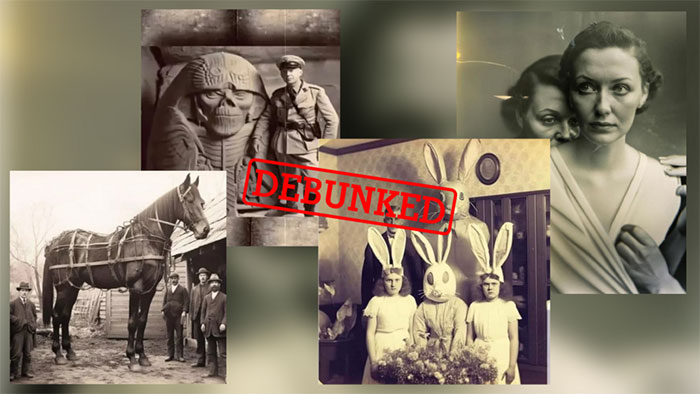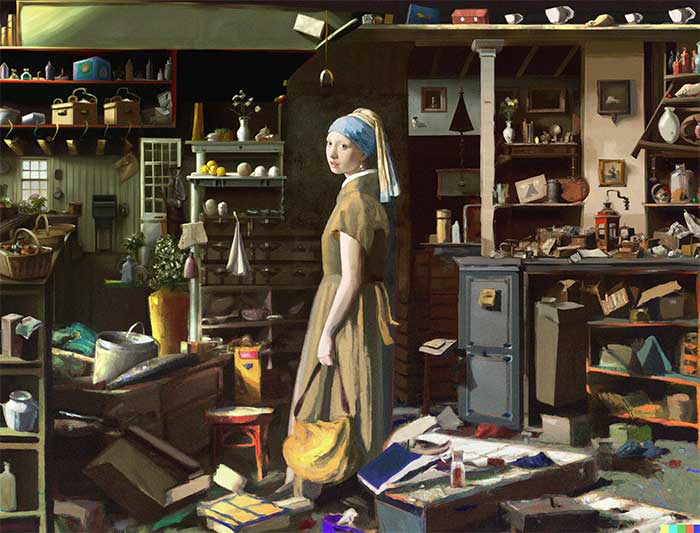How is artificial intelligence used to create fake history?
Artificial intelligence (AI) has revolutionized many different aspects of our lives, including the way we access and interpret historical information.
While AI has the potential to enhance historical research and analysis, it also poses a significant challenge: the ability to create convincing fake historical information. This article will explore the new landscape of AI-generated historical content , delving into its potential applications, ethical concerns, and impact on our understanding of the past. past.

AI has the ability to recreate historical events and characters.
AI-powered historical reconstruction
AI has the ability to recreate historical events and figures, bringing them to life in ways that were previously unimaginable.
One of the important applications of AI in history is the restoration and preservation of historical artifacts. Machine learning algorithms can analyze damaged or degraded artifacts, such as manuscripts or ancient works of art, and digitally restore them to their original state. This process helps historians and researchers gain a more accurate understanding of the past.
AI can be used to create immersive virtual recreations of historical sites, buildings, and landscapes. Through the use of 3D models and historical data generated by AI, we can go back in time and explore ancient cities, temples, and monuments as they were. This technology allows historians to conduct virtual archeology and gain new insights into the past.

AI can create virtual avatars of historical figures.
AI-driven algorithms can also bring historical figures to life, at least in a digital sense. By analyzing historical texts, portraits, and other records, AI can create virtual avatars of historical figures, allowing us to interact with them through interactive experiences. While this may provide a unique educational opportunity, it raises questions about historical accuracy and authenticity.
Historical text generated by AI
Artificial intelligence can be used to create historical texts, including documents, letters, and even tomes.
AI models such as GPT-3 (Generative Pre-trained Transformer 3) have demonstrated the ability to generate text that mimics the writing style of historical figures or specific time periods. This technology can be used to create documents that appear to be historically accurate, potentially being used for educational or research purposes.

AI-generated photo of early robot existence. (Source: Public Domain).
The fact that AI can easily generate text is also a significant challenge. However, bad actors can use AI to create fake historical documents, spread false information or even fabricate entire past events. This raises concerns about the reliability of historical sources and the possibility that AI-generated forgeries could mislead researchers and the public.
Solving the problem of AI-generated historical text requires developing tools and techniques to detect such content. Researchers and organizations are working on AI algorithms that can identify text generated by AI models, helping to ensure the integrity of historical research and publications.
Ethical and historical significance
As AI-generated historical content becomes more popular, the question of authenticity becomes paramount. Can we trust AI-generated historical texts and reconstructions to be accurate representations of the past? Historians and researchers must critically evaluate AI-generated content sources and consider their potential biases and inaccuracies.

Another photo of a giant horse created by AI. (Source: Public Domain)
AI-generated historical content, if not used responsibly, has the potential to distort our understanding of history. It can perpetuate false narratives, reinforce stereotypes, or even erase certain historical events or figures. Historians and educators have a responsibility to ensure that AI-generated content conforms to the principles of historical accuracy and objectivity.
Integrating AI into historical research and education offers exciting opportunities for innovation. However, it also requires striking a delicate balance between embracing technological advances and maintaining traditional methods of historical inquiry. Historians must navigate this evolving landscape thoughtfully and ethically.
Fight against fake history created by AI
To address the challenges posed by AI-generated fake histories, several strategies and protections are being considered.
Historians and researchers must apply rigorous fact-checking and verification processes when encountering AI-generated historical content. Cross-referencing with established historical sources and conducting thorough research remains essential to ensure the accuracy of information.

Another photo of a giant dog created by AI. (Source: Public Domain)
Creators of AI-generated historical content must be transparent about their use of AI and clearly label that content to distinguish it from historically verified sources. This transparency helps users distinguish between AI-generated content and historically accurate information.
Education plays an important role in equipping the public with the skills to critically evaluate historical information, whether generated by AI or pulled from traditional archives.
Artificial Intelligence is undeniably changing the way we interact with historical information, providing new tools to research, reconstruct and engage with the past. However, the rise of AI-generated historical content also poses challenges related to authenticity, accuracy and ethics. As we navigate this evolving landscape, it is important for historians, educators, and the public to remain vigilant, employing rigorous fact-checking, transparency, and impartiality. Critical thinking to protect historical integrity in the age of AI-generated content.
- Nvidia's new AI creates incredibly fake fake videos
- Artificial intelligence: Development history and future potential
- Artificial intelligence has learned how to create another artificial intelligence
- This AI system will create images from the input text
- What is Artificial Intelligence? What is AI (artificial intelligence)?
- AlphaGo's victory: Great event in the evolutionary history of mankind
- China wants to dominate global artificial intelligence
- Caterpillars fake ants tricking artificial intelligence
- IBM's artificial intelligence invented new perfumes
- The United States allows the use of artificial intelligence to diagnose diseases
- For the first time in history, artificial life saved a life
- Alien artificial intelligence may be watching Earth
 The world's first sexless AI voice
The world's first sexless AI voice This cool t-shirt will make you invisible to AI
This cool t-shirt will make you invisible to AI AI can predict personality only through selfie photos
AI can predict personality only through selfie photos The world-famous chess player lost to Golaxy before, artificial intelligence 'made in China'
The world-famous chess player lost to Golaxy before, artificial intelligence 'made in China'